 Sunday/Weekend
Sunday/Weekend

A man born on a mattress made by his native village artisans tries to gain a fresh lease of life for the traditional craft with new, market-oriented designs, Phước Bửu reports
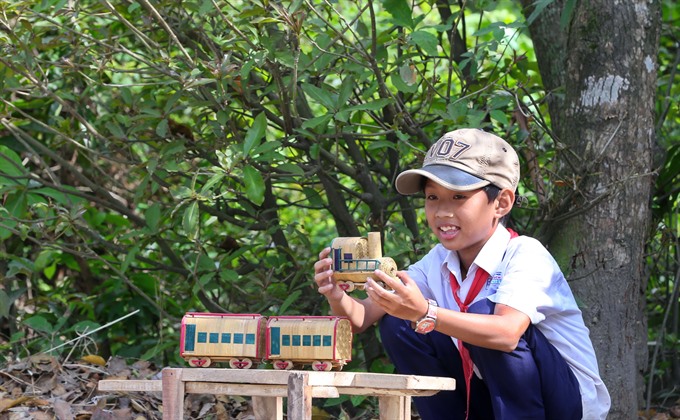 |
| Something to smile about: A boy plays with a train made by Nam. VNS Photo Huê Phong |
A man born on a mattress made by his native village artisans tries to gain a fresh lease of life for the traditional craft with new, market-oriented designs, Phước Bửu reports
Nguyễn Viết Nam was born on a mattress woven by highly skilled artisans.
He was not the only one, of course.
The mattresses produced by artisans of Phò Trạch Village in the northern part of Thừa Thiên-Huế Province using craft skills handed over through generations have also welcomed the birth of generations of babies in the village and beyond.
For Nam, the knitting of dry, grey rush stems has been an indispensable part of his conscious life, and the awareness of his native village’s craft legacy has only deepened over time.
For decades, Nam has been struggling to expand the market for the village’s mattresses, so that local weavers can earn higher incomes and their traditional craft thrives in the face of mass-produced industrial products.
"It is not just me that was born on these mattresses, but many generations in this village. Obviously, the craft is a legacy of my community and many among us want a healthy life for this craft.
“Losing it would be like losing a part of my life and the village’s history.”
 |
| Headgear: An elderly artisan knits a hat in Phò Trạch Đệm Village. VNS Photo Huê Phong |
Half a millennia
The craft dates back to the 16th century, with pioneer residents from the northern part of the country following their commanders, who later became the Nguyễn Lords (1558-1777), settling down in the village.
The early residents recognised that the village had many marshes and rush plants growing naturally in them. They found that the plant had a hollow cylindrical stem and if these were flattened and dried, they would become durable.
They invented a tool like a wooden hammer to flatten a bundle of the stems at the same time before drying them in the sun.
Then they started knitting these “threads” to make mattresses and this became the village’s mainstay for generations. The village’s name became Phò Trạch Đệm. The word đệm means ‘mattress’ in Vietnamese.
For centuries, the villagers relied on this craft to augment their income from agricultural cultivation. In their heyday, they were the sole suppliers of mattresses throughout Thừa Thiên-Huế and neighbouring provinces.
They made mattresses for beds, for floors to be used as carpets, and for baby cradles. The mattresses’ characteristics were amazing. They were soft, because of the air that remained in the flattened stems; they were also able to absorb water, a useful feature for babies; they were washable; and they give off a cool feeling during hot, sunny days.
Even today, Huế residents prefer rush mattresses for babies rather than plastic ones. However, sales of other products have declined.
Only nostalgic rural customers continue to consume the mattresses produced in the village.
"The traders pay me very little, around VNĐ 50,000 đồng (over US$2) for a mattress that I spend at least a week knitting," said an elderly woman in the village who did not want to be named. She said the traders blamed low sales for their low buying prices.
The decline in sales is forcing the craft to fade out. Most younger residents have left the village, looking for other jobs with better incomes. The craft is now in the hands of elder artisans and housewives.
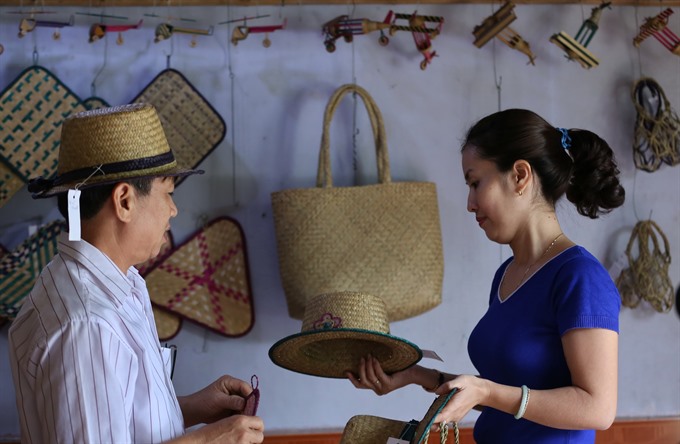 |
| Tagged: Nam introduces his products to a representative of the Phương Nam craft sales outlet. VNS Photo Huê Phong |
Nam to the rescue
Saddened by the plight of the villagers and their traditional craft, Nam, as the deputy head of village’s agriculture co-operative, gave the body a new direction in 2000.
He organised a team of skillful artisans to make mattresses and products, including handbags, sofa mats and hats.
Those products became popular in the market, before the handmade items were overtaken by trendy fabric hats and plastic bags. Eventually, the knitting section was eliminated from the cooperative after Nam was removed through trickery.
"I left the village to earn an income in Quảng Bình, the native province of my wife. But I have never stopped thinking of the craft," Nam said.
Far away from home, Nam designed samples using cut pieces of knitted mattresses as way to deal with his homesickness.
Last year, he decided to make a determined comeback to his home village and work on creative products made with pieces of knitted mattresses.
"Only creativity would work. I think that traditional handicrafts cannot compete with mass-produced items, so a transformation in the way they (traditional products) are used is necessary.”
Late last year, Nam had his new products make their debut and they were welcomed by locals and visitors to a festive event held in Phước Tích Village by the organisers of the biennial Huế Festival.
Today, he has almost 150 designs for sofa mats, lanterns, tissue boxes and desk lamps, and key rings in different shapes, including fish, Santa Claus, Doraemon, 12 Zodiac animals and the Dharma Wheel of Buddhism.
“I want to meet the demands of customers of all types and ages,” he said. “Whatever is good for the sale of rush mattress, I will do.”
Nam has designed many toys for kids, too – cars, planes, trains, etc.
For producing his items, Nam purchases complete mattresses from locals and cuts them into smaller pieces for his works. For complicated designs, he does the knitting himself. Luckily, Nam’s creativity and skills have been accepted in the market.
"These are so good, and it is great that they help consume the knitted mattresses," said Nguyễn Văn Lợi, who was seeking “nostagic products”. Pleased at his discovery during an accidental visit to Nam’s workshop, he said: "The items here are artistic and attractive for people of different ages.”
Recently, Nam has received orders from the Phương Nam arts and crafts outlet, an organic food supermarket Quế Lâm in Huế and potential traders from Đà Nẵng and HCM City, who met him at the Huế Craft Village Festival held in the city earlier this month. Nam was invited to the festival as a representative for new craft products.
Higher sales of Nam’s products mean stronger hopes of survival for the 500-year craft.
With increased interest in organic product consumption in the country and elsewhere, Nam seems to have done the right thing at the right time. VNS
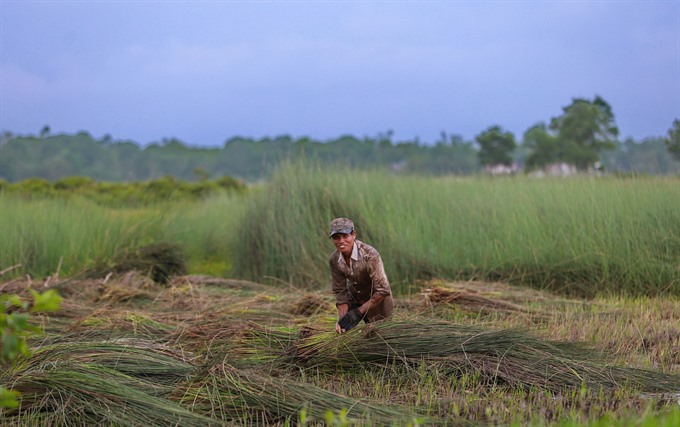 |
| Raw material: A farmer harvests rush plants. VNS Photo Huê Phong |
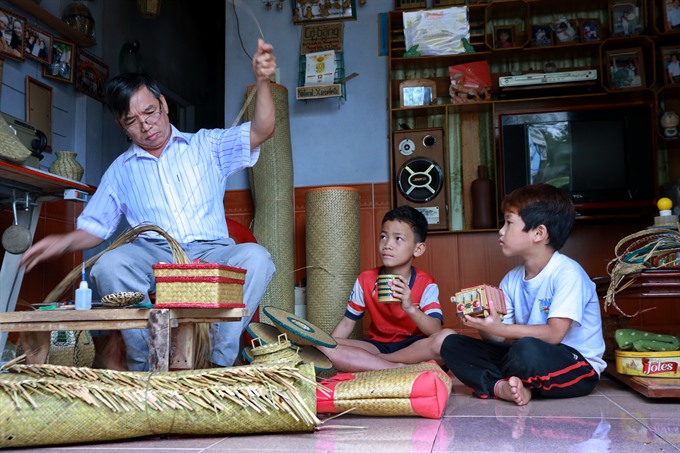 |
| Watch this: Two children are all eyes as Nam makes a basket using a rush mattress piece. VNS Photo Huê Phong |
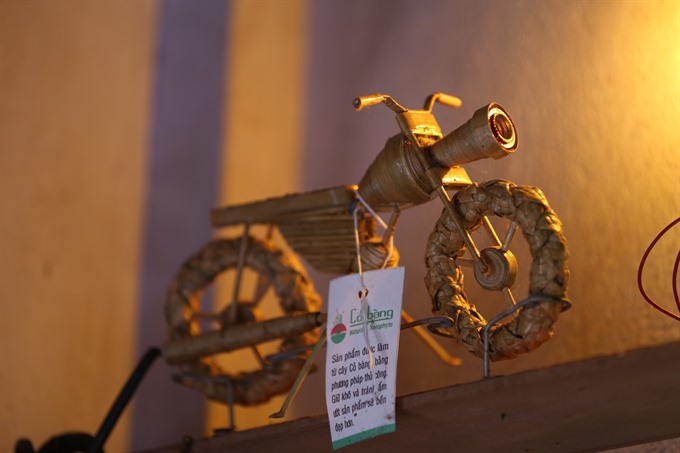 |
| For show: A motorbike made by Nam. VNS Photo Huê Phong |
 |
| Fowl play: A Phương Nam Craft Sales outlet representative holds a rooster lamp made by Nam. VNS Photo Huê Phong |